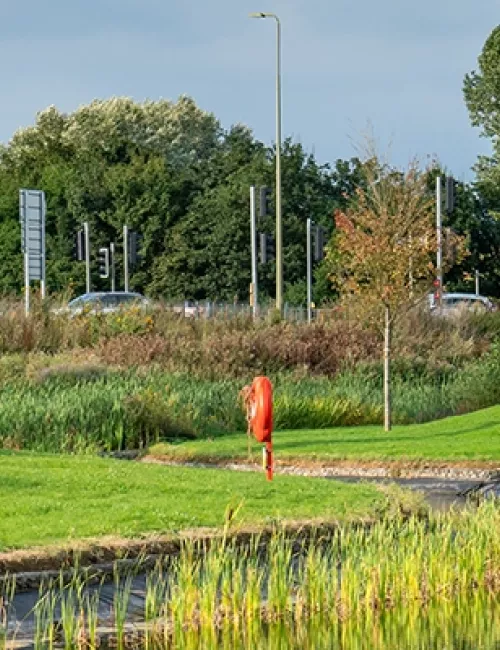Working closely with local planners and other stakeholders in Bicester and beyond, ECI and partners Forest Research tested a range of practical tools for mapping and assessing GI, and develop clear step-by-step guidance for users.
Our work
This project aimed to test a range of existing tools for planning and evaluating green infrastructure, using the rapidly expanding town of Bicester in Oxfordshire as a case study. The ECI and Forest Research worked in partnership with many stakeholders to develop a set of simple tools and methods that can be applied relatively quickly and easily.
These form a toolkit that can help local authorities to:
- map green infrastructure and the ecosystem services it provides
- map ecological networks (wildlife corridors)
- check whether a new development achieves net gain in biodiversity and natural capital
- assess the benefits of new and existing green infrastructure
- decide where new or improved green infrastructure is needed
- follow best practice guidance.
Although the toolkit has been tested in Bicester we hope it will be useful to local authorities in other parts of the UK.
Background
What is green infrastructure?
Green infrastructure is the network of green space and water features, both urban and rural, that provides multiple environmental benefits for people. It includes semi-natural habitats such as woodland, grassland, heath, wetland, lakes and rivers, as well as parks, gardens, sports fields, playgrounds, cemeteries, allotments, orchards, amenity grassland and canals. On a smaller scale it covers roadside verges, street trees, flowerbeds, shrubs, hedgerows, footpaths and cycle paths, and engineered features such as sustainable drainage systems (e.g. retention ponds, swales or raingardens) and green walls and roofs. Sometimes water features are referred to separately as 'blue infrastructure', but here we use 'green infrastructure' to refer to both green and blue infrastructure.
Green infrastructure is essential to our quality of life. It provides places for recreation and relaxation, attractive views, connection to nature and a sense of place, as well as practical benefits such as flood protection, shading and cooling, improved air and water quality, carbon storage and habitat for pollinators and other wildlife.
Tools for planning green infrastructure
Green and blue space is often threatened by new development, and is also under pressure from air and water pollution, climate change and invasive species. At the same time, new development offers opportunities for building new high quality green and blue infrastructure, or releasing funds to upgrade existing habitats to compensate for any losses. As budgets are squeezed, local councils need tools to show the value of existing green infrastructure, find out where new or improved green space is needed and make the business case for investment. However, although many tools exist, few are freely accessible, robust, easy to use, capable of assessing a wide range of ecosystem services, suitable at the urban scale and valid in the UK context.
Bicester and beyond
Bicester will double in size over the next 15 years. However, the Cherwell District Council Local Plan aims to create high quality and sustainable new developments including a high proportion of green and blue space. The council approached the University of Oxford to help identify suitable tools for planning and evaluating green infrastructure, given their limited time and budgets. Working with a wide range of stakeholders, and with funding from NERC, we tested a set of tools which are cheap or free, relatively quick and easy to use and draw on readily available datasets. Although we used Bicester as a case study, we hope that the results will be useful to other local authorities.
The methods developed for the Bicester study are now being applied more widely. We have applied the ecosystem service scoring method to produce natural capital maps of Oxfordshire to help inform development of the Oxfordshire Plan to 2050, and we have also produced natural capital maps of the Oxford-Cambridge growth arc, as a tool to feed in to development of Local Natural Capital Plans. See Alison's presentation on YouTube.
Toolkit
The toolkit includes tools that can be used for:
- Mapping green infrastructure
- Mapping the ecosystem services provided by green infrastructure
- Mapping ecological networks
- Assessing land-use change (including net gain in biodiversity and natural capital)
- Valuing the benefits of new or existing green infrastructure, in monetary or non-monetary terms
- Opportunity mapping: deciding where new or improved green infrastructure is needed
- Guidance: following best practice guidance and learning from case studies
The focus of this project has been on finding relatively quick and simple tools that could, in theory, be applied by local councils with limited time and resources. However, most of the tools listed below require a certain amount of time and expertise, with many relying on use of a Geographic Information System (GIS) to generate maps and analyse spatial data. Realistically, councils with limited in-house GIS expertise may choose to use third party consultants or facilitators such as their local Environmental Records Centre to carry out much of the analysis.
There is also a trade-off between simplicity and robustness of the tools. More complex tools are available, such as InVEST (free), LUCI (proprietary), SENCE (consultancy) and Viridian (consultancy), which model processes such as rainwater runoff and soil erosion taking into account rainfall, soil type and the slope of the land. These require more time, expertise and data (or payment to consultants), but can produce more robust results for the services of flood protection, soil erosion and water quality regulation. Further details of these tools and others can be found on the EKN Tool Assessor website.
Mapping existing assets
What green infrastructure assets do we have already? What should be protected?
- Base maps, pdf (4 pages, 414 KB)
- Ecosystem service scores, pdf (26 pages, 3 MB)
- Participatory maps, pdf (18 pages, 1.3 MB)
- Social media
Opportunity mapping
Where are there gaps in supply? Where are the best opportunities for investing?
- Scores and rules
- EcoServ-GIS – updated to EcoservR
- ANGSt, pdf (98 pages, 2.8 MB)
- Participatory maps, pdf (18 pages, 1.3 MB)
- Network mapping
Site design
How can we plan good green infrastructure? Are we achieving net gains of ecosystem services?
- NCPT
- Eco-metric
- Green factor scores
Valuation
What will the benefits be? Can we make a business case?
Outputs
Natural capital in Oxfordshire
A short report of the method used to generate preliminary Natural Capital maps for Oxfordshire. The work was undertaken under an Oxford Policy Exchange Network fellowship, enabling Alison Smith to work with Oxfordshire County Council, with support from Cherwell District Council, and develop evidence on natural capital to feed into development of the Oxfordshire Plan to 2050.
Guidance note: Creating a green infrastructure base map
This short guidance note lists potential datasets that can be used to create a base map of existing green infrastructure assets, and suggests how they could be combined into a single asset map.
Land-cover scores for ecosystem service assessment
A short report that describes a simple method for mapping ecosystem services based on scoring different types of land cover from 0 to 5, depending on their ability to supply different services. We applied this approach to the Bicester area, by adapting a matrix of land-cover scores generated from a study in Warwickshire, Coventry and Solihull.
The value of green space in Bicester to local people
This guidance note presents evidence on the value of Bicester’s green spaces to local people, gathered through a public survey in summer 2017, using interviews, a focus group and an online app; and through a new online tool called ORVal that estimates the welfare value of green spaces for recreation anywhere in England.
- Town and Country Planning Association, 2018. Guide 7: Planning for green and prosperous places. London: Town and Country Planning Association.
- Smith, A. 2017. Bicester and beyond. March, UK: IEMA.
- Smith, A., Berry, P., Barker, J. and Lazarus, N. 2019. A toolkit for planning and evaluating urban GI – in Bicester and beyond, pdf (64 pages, 4.9 MB). In: Town and Country Planning, Special Issue on Mainstreaming Green Infrastructure, pp 29. Scott, A. (ed).
- Vaz Monteiro, M., Handley, P., Doick, K.J., Smith, A. (2018). i-Tree Eco valuation of public trees in Bicester: a provisional analysis, pdf (38 pages, 882 KB). Farnham, UK: Forest Research, Farnham.
Partners
- Environmental Change Institute, University of Oxford
- Forest Research (BEETLE and iTree-Eco tools)
- Cherwell District Council
- Bioregional Development Group
- Bicester Town Council
- Oxfordshire County Council
- Oxfordshire Local Enterprise Partnership
- A2Dominion Housing Group Ltd
- Berkshire, Buckinghamshire and Oxfordshire Wildlife Trust (BBOWT)
- Wild Oxfordshire
- Environment Agency
- South Downs National Park Authority
- The Mersey Forest
- Green Infrastructure Partnership, Town & Country Planning Association (TCPA)
- Ecosystems Knowledge Network



